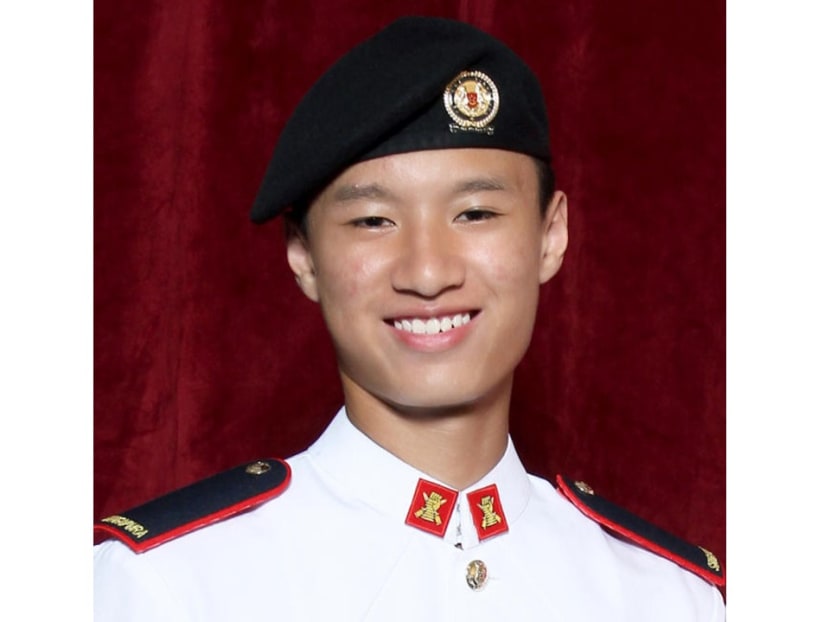Ex Wallaby incident: Difficult terrain, ‘significant portion’ of NSF’s body protruding from vehicle led to death
SINGAPORE — The harsh terrain, and a full-time national serviceman's decision to position a "significant portion of his body" outside the military vehicle he was commanding were among the factors that led to his death during a military exercise in Australia last September.

Third Sergeant (3SG) Gavin Chan, 21, had died after the Bionix Infantry Fighting Vehicle he was guiding out of difficult terrain — dotted with a steep incline and boulders — overturned.
SINGAPORE — The harsh terrain, and a full-time national serviceman's decision to position a "significant portion of his body" outside the military vehicle he was commanding were among the factors that led to his death during a military exercise in Australia last September.
Third Sergeant (3SG) Gavin Chan, 21, a vehicle commander from the 41st Battalion Singapore Armoured Regiment (SAR), had died after the Bionix Infantry Fighting Vehicle he was guiding out of difficult terrain — dotted with a steep incline and boulders — overturned.
Addressing the House on Thursday (May 17) in his ministerial statement on recent training-related deaths in the Singapore Armed Forces (SAF), Defence Minister Ng Eng Hen released detailed findings on the death of the serviceman during Exercise Wallaby at the Shoalwater Bay Training Area in Queensland.
Noting that all investigative processes have been completed, including those by the Queensland authorities, Dr Ng said 3SG Chan died as a result of multiple injuries sustained due to motor vehicle trauma.
With permission from 3SG Chan's parents, the minister circulated the report from the Queensland Coroner, except the post-mortem findings, to members of the House, and took them through it.
On the night of the incident, the Queensland Coroner noted that the soldier had given orders for the driver of the vehicle to reverse slowly down a hill after its path forward had been obstructed.
3SG Chan was stationed in the turret — a low armoured tower rising from the middle of the vehicle — with his "upper body clear of the vehicle structure", as he directed the driver.
The vehicle then moved over a flat granite rock for about 4m before it became stuck on a large boulder.
With the vehicle's undercarriage held up, 3SG Chan instructed the driver to turn the steering wheel in an effort to gain traction, when it suddenly tumbled over the rock. It then rolled sideways before coming to a stop further down the slope.
The impact flung the serviceman from the vehicle, inflicting "significant injuries", said the coroner.
The police had found no defect with the vehicle, and the driver had been reversing very slowly, on 3SG Chan's instructions, the coroner added.
"The police considered that it was likely that the incident occurred because of the commander's decision to reverse on a slightly different path down the hill and that his choice to be positioned with part of his body outside the vehicle exposed him to greater risk of injury," the coroner said.
The coroner also noted that the SAF's recommendations are that only the head and shoulders be positioned outside the turret during operations.
Adding that the findings from the Queensland authorities corroborated with the findings from an independent Committee of Inquiry (COI) appointed by the Armed Forces Council in Singapore, Dr Ng said several lapses had been identified by the committee.
For one, the night vision device of the vehicle was not functioning. Armoured vehicles are allowed to move at night without the use of the device, which allows soldiers to see in darkness, only with the driver’s hatch open and headlights on for increased visibility.
As the vehicle commander, however, 3SG Chan chose to carry on training without the headlights because he felt they would “give away their position to the enemy”.
Dr Ng said: “Accounts from his platoon mates to the COI attest to 3SG Chan’s strong motivation and high standards of performance during training. (He) was zealous in his training and probably wanted to complete the night mission assigned to their armour unit.”
Three other soldiers who were within the Bionix were not hurt.
"It is unfortunate that he took the decision to position himself with a significant portion of his body exposed outside the vehicle," the Queensland Coroner concluded.
"There is nothing to suggest that the incident is none other than a very unfortunate accident due to the nature of the difficult terrain and the operation then being performed."
The police did not find any basis to charge anyone, while the COI also found no negligence, foul play or misconduct in the incident.
3SG Chan was accorded the honours of a military funeral about a week after he died. The SAF has also offered compensation to his family for the training-related death.
Dr Ng said since the incident on Sept 15 last year, the SAF has tightened training safety regulations to limit the exposure of the vehicle commander's body to the waist when carrying out certain operational tasks. This ensures sufficient reaction time for the commander to lower his body into the vehicle if it overturns.
Besides additional training for armoured vehicle commanders negotiating uneven terrain, the SAF has also put in place drills formalising the actions for day-to-night and night-to-day transitions, including a check on the serviceability of a vehicle's night vision device and other night-fighting equipment as part of a checklist.
Checks on wearing of seatbelts are also enforced, and disciplinary action will be taken against those found in breach of safety, Dr Ng added.











